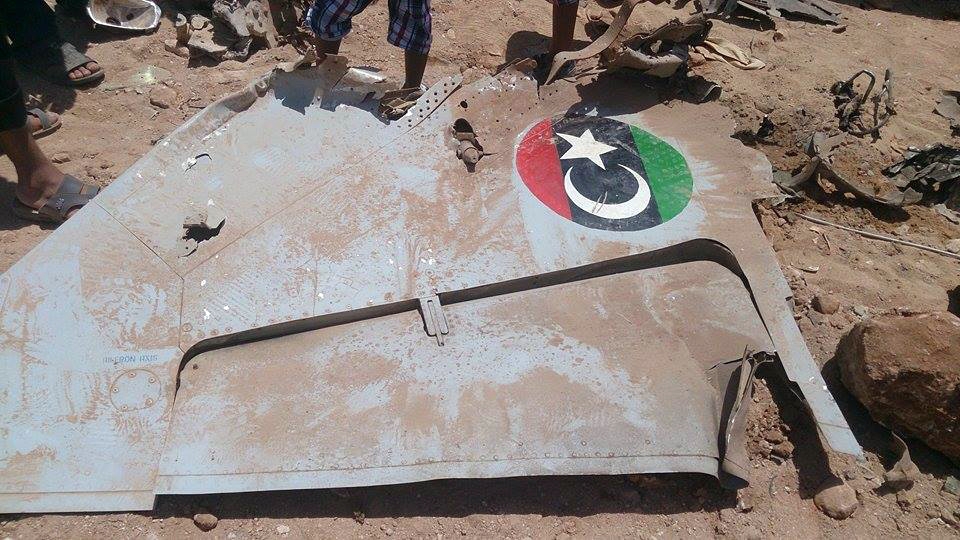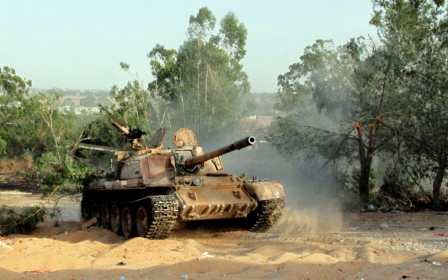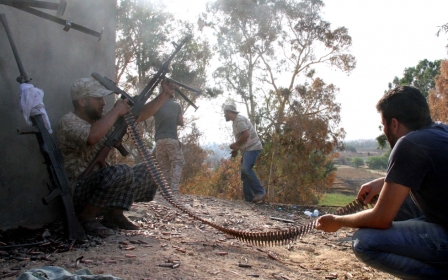Mystery air strike raises specter of invasion in Libya

Mystery air strikes that pounded militia bases in the Libyan capital, Tripoli on 18 August have revived speculation in Libya about the “i” word - Intervention by outside powers.
Bombing raids on Sunday night and the early hours of Monday morning struck a Misratan militia base at Qasr Ben Gashir which had been used to bombard the nearby Tripoli airport for the past month, killing six militiamen.
But Libya’s government denies it was behind the strikes.
Chief of staff Major General Suleiman Obeidi said the strikes were precise, using laser-guided bombs at night, which were beyond the technical capabilities of its air force.
Misratan and allied Islamist Libyan Revolutionary Operations Room militias, who have been bombarding the airport for the past month, insisted the attacks were from Operation Dignity, a force led by former general Khalifa Haftar which has been battling Islamists for the past three months.
Air Force units aligned with Haftar have indeed struck Islamist bases in the eastern town of Benghazi since May, but Obeidi insisted those planes lack the range and technology for accurate night-strikes.
Libya’s new parliament, the House of Representatives, followed its government in denying all responsibility for the air strikes, which also hit an ammunition dump south of Misrata. Further confusion followed a statement from an Operation Dignity commander, air force brigadier Saqr Geroushi, who said the attack was aided, but not necessarily carried out, by pro-Dignity forces.
France and Italy both rushed out statements denying involvement, with some Libyans speculating that Algeria and Egypt may be involved. NATO, which monitors Libyan air space, has yet to comment, though its surveillance planes operating over the Mediterranean will have tracked the bombers.
Haftar is known to have at least two combat jets and an attack helicopter, both of which have carried out repeated strikes on Islamist brigades in Benghazi and on ships it alleges are bringing Islamists ammunition in eastern ports. If those air units were responsible, then they are likely to have found a more western base to operate from, as Libya has no means of providing air-to-air refueling.
Air power, whether Libyan or foreign, could potentially be a decisive element in the battle for Tripoli which has been raging for over a month. Fighting continues between a coalition of Islamists and Misratan brigades against another coalition of nationalists led by brigades from Zintan and the Warshefani region west of the capital.
Fighting began in July when the Misratans and Islamists began attacks on Tripoli’s international airport, held by Zintani units. Since then front lines have evolved across the south west of the city, where Zintan holds a wedge-shaped area stretching from the airport down to the coast. Islamist and Misratan units are engaged on both sides of this salient, the battle complicated by attacks by Warshafani units on an Islamist base, Camp 27, west of the city which controls the coastal highway.
Neither side is able to score a strategic victory and the price is being paid by ordinary residents, as destruction spreads through the south western suburbs, with rocket fire this week striking Gagaresh, one of the city’s most affluent districts.
Similar deadlock is in place 400 miles (643 kilometres) to the east, where the struggle between Islamist brigades and a mixture of Dignity and army units has been waged since May. There, Islamist units have withstood attacks and this month made advances, capturing several army bases and pushing towards the city airport.
With the new parliament, the House of Representatives, lacking security forces of its own, intervention - diplomatic or military - is likely to be the only way to end the fighting.
On the diplomatic front the United Nations and European Union, having evacuated Tripoli in July, have sent a small number of officials back to Libya to try and initiate ceasefire talks. Those calls have got nowhere, in part because none of the combatants is facing defeat and sees the point in negotiations. Without mediation, speculation is turning to the possibility of outside military intervention.
NATO powers intervened decisively in Libya in 2011 with a six-month air campaign that smashed the forces of Muammar Gaddafi, delivering victory for rebel forces.
Last year, former US secretary of State Hillary Clinton reminded Libya that the UN resolution, 1973, which empowered NATO in 2011 remains active. The basis of that resolution was that NATO member states could intervene to strike forces that were bombarding civilians, and legally, NATO retains the power to do it again.
Libya itself has called in recent weeks for limited intervention. In July, foreign minister Mohammed Abdul Aziz travelled to New York to ask for military advisors to bolster its units defending strategic sites. This month, the House of Representatives, meeting in Tobruk, one of the few Libyan cities to be spared militia violence, made the same call.
To date those calls have fallen on deaf ears, and the reason is simple; there is no clear objective.
Back in 2011, the objective was simple; Most of Libya’s population had risen-up against Muammar Gaddafi, and his forces were bombarding them. Bombing would neutralize Gaddafi’s artillery and provide a platform for rebel militias to win the war.
Now, however, those same militias are at war with each other, with a broadly Islamist coalition battling non-Islamist forces, with ordinance from all sides striking civilian areas.
NATO, in other words, would face having to bombard all sides, its planners having to decide whether such-and-such a gun or rocket-launcher was firing on civilians and was thus within the 1973 resolution legal mandate to be bombed.
While NATO states worry about intervening in a messy multi-sided conflict, they worry also about the consequences of non-intervention.
In April, France’s defence minister, Jean-Yves Le Drian, said that southern Libya had become a crossroads for militants moving between Algeria, Mali, Niger and Nigeria, calling the area a “vipers nest”. In May the UN Security Council’s Al-Qaeda sanctions committee reported al-Qaeda units from Algeria and Mali deploying in southern Libya.
French fears are that militants are basing themselves in Libya, taking advantage of the chaos, and benefitting from the country’s rich oil revenues. For Paris, London and Washington the nightmare scenario is that these groups use Libya as they once used Afghanistan, as a base for attacks on western cities.
How realistic these concerns are is impossible to assess, because al-Qaeda does not comment and the West does not make public its intelligence.
But Washington has already signaled its willingness to send combat units into Libya for pin-point strikes. Last year Delta Force commandos flew into Tripoli to capture Anas al-Libi, now on trial accused of bombing the US embassy in Kenya in the 1990s. Earlier this year, another raid snatched Ahmed Abu Khattala, also awaiting trial accused of involvement in the attack on the US consulate in Benghazi two years ago that led to the death of ambassador Chris Stevens.
And the West also worries about the consequences of Libya becoming a failed state, a land in which militias roam at will, and one on the shores of the Mediterranean. Already the absence of government has made Libya a funnel for hundreds of thousands of migrants moving north through the Sahara in search of a boat to Europe.
For the moment, Western powers are struggling to assess the scope of Libya’s fighting. If it evolves into a battle between two sides, one of them backed by the government, there may be a basis for military intervention, perhaps coupled with a government demand for militias to cease fire or face attack. If, on the other hand, the fighting devolves into a multi-sided war, such intervention becomes problematic and the language will shift from intervention to containment.
Middle East Eye propose une couverture et une analyse indépendantes et incomparables du Moyen-Orient, de l’Afrique du Nord et d’autres régions du monde. Pour en savoir plus sur la reprise de ce contenu et les frais qui s’appliquent, veuillez remplir ce formulaire [en anglais]. Pour en savoir plus sur MEE, cliquez ici [en anglais].




